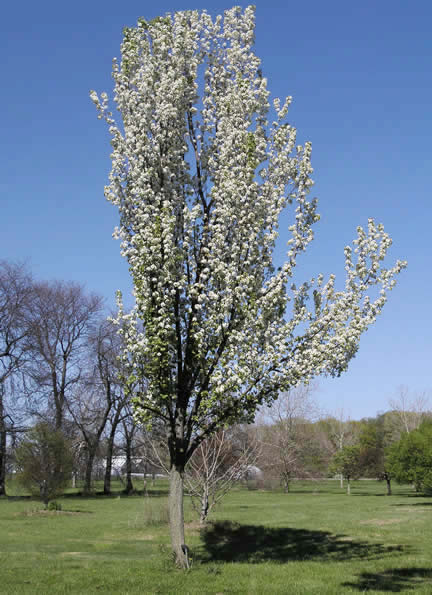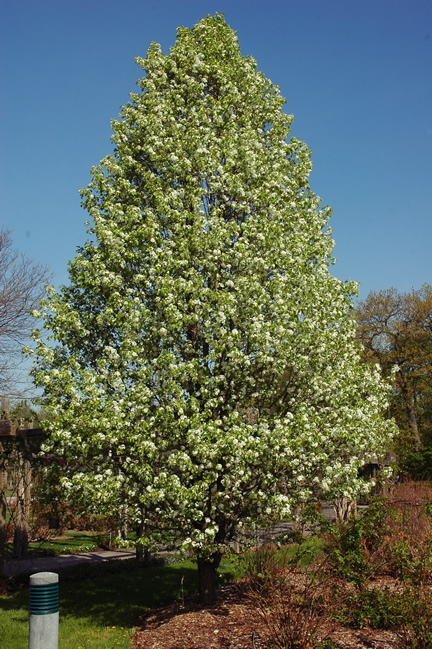| General Description | Ornamental, fast-growing hardy tree with thorns on the stems at a young age. Odorous flowers producing small, brown, inedible fruit. Leaves are rounded, dark green and glossy. |
| ID Characteristic | P. calleryana is a medium sized tree with multiple branches often growing in thickets. The fruit is a small brown, rounded pome. It has clusters of 6-12 white flowers producing an unpleasant odour. |
| Shape | Upright, slightly pyramidal form when young progressing to a narrow rounded crown with horizontal branches towards maturity. |
| Landscape | It may be used as an ornamental tree in urban areas and is often seen growing in masses along highways. Now tagged as an invasive species, cultivars of P. calleryana are today commonly used in urban landscapes instead of the species. |
| Propagation | Commonly through seed, although plants are self-incompatible. Cold stratification for 60 days at 4°C is required. Rinse fresh seed with cold water and dry under shade for 48 hours prior to the stratification process. Seeds have a second dormancy if exposed to warm temperatures in late winter. |
| Cultivation | Tolerant of many soil types including clay and pH levels from 5-7.5. It does best in full-sun and open areas and performs poorly as an understory tree, not surviving where temperatures drop below -28°C. |
| Pests | Fireblight and leaf rust are potential problems. |
| Habitat | Found in wetlands, mountain-sides, and open plains in China and Korea. This tree has a low shade tolerance and grows poorly as an understory species and is thus commonly found growing in open areas. |
| Bark/Stem Description | Light brown with a smooth texture when adolescent. Greyish-brown colour and shallow furrows with scaly ridges when mature. |
| Flower/Leaf Bud Description | Large reddish-brown buds 1.5 cm in length, often tomentose with white fuzzy hairs. |
| Leaf Description | Alternate, simple, broad-ovate to ovate with an acuminate tip and crenate margins. 8 cm across and 4-7 cm in length. Glossy, dark green on top and pale, light green below. |
| Flower Description | 5 petalled, dehiscent white flowers, 5-7 cm across held in inflorescence of 6-12 blooms producing an odorous scent. |
| Fruit Description | Small, brown, inedible, fruit 2 cm in diameter turning soft in late autumn. |
| Colour Description | Colour of foliage varies from glossy, dark green in the summer to red, orange, yellow and purple in the autumn. In spring white flowers in clusters of 6-12 encompass the entire plant. The bark is light brown while the fruit is brown and covered with tiny russet dots. |
| Texture Description | Medium textured in both summer and winter. |

